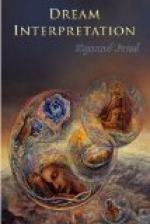
|
| Name: _________________________ | Period: ___________________ |
This test consists of 15 multiple choice questions and 5 short answer questions.
Multiple Choice Questions
1. The first category of dreams is classified as _____.
(a) Highly psychic.
(b) Electrically charged.
(c) Intelligible.
(d) Devoid of intellect.
2. The second group of dreams poses the problem of being unable to reconcile their meaning with _____.
(a) Mythological references.
(b) Mathematics.
(c) Mental life.
(d) Physiology.
3. The ego of Mr. M--- in Freud's dream is represented as a _____.
(a) Doer of evil.
(b) Coercive element.
(c) Constant source of pain.
(d) General paralytic.
4. The condition of the dream's _____ is a problem in the study of dreams that Freud feels needs addressing.
(a) References.
(b) Expiration.
(c) Characters.
(d) Origin.
5. Where is Freud sitting with Mrs. E.L. in his dream?
(a) On an over-sized armchair.
(b) On a sofa.
(c) Under an awning.
(d) At a table d'hote.
6. The _____ are longer in the third category of dreams.
(a) Sleep deprivation times.
(b) Narrative commentaries.
(c) Dream plots.
(d) List of family characters.
7. One medical writer characterizes dreams as a physical process that is always useless and frequently _____.
(a) Contrary.
(b) Decisive.
(c) Elevating.
(d) Morbid.
8. Mrs. E.L. was the daughter of a man to whom Freud _____.
(a) Written query letters.
(b) Sent applications.
(c) Owed money.
(d) Sent money.
9. What sort of trip did the three-and-a-half-year-old girl go on?
(a) Plane.
(b) Sea.
(c) Hiking.
(d) Carriage.
10. What word from the dream of Mrs. E. L. has a double meaning?
(a) Table.
(b) Spinach.
(c) Roast.
(d) Cost.
11. According to Freud, conversion of the latent thoughts into manifest thoughts _____.
(a) Deserves close study.
(b) Should be ignored initially.
(c) Has mystical implications.
(d) Is completely useless.
12. What was the antique shawl that Freud gave one of his friends a charm against?
(a) The plague.
(b) The Malocchio.
(c) Dragons.
(d) Animal spirits.
13. What was painted on the antique shawl Freud gave to one of his friends?
(a) Trees.
(b) Cats.
(c) Flowers.
(d) Eyes.
14. How does Freud say that dreams were regarded by pre-scientific people upon wakening in terms of manifestation of higher powers?
(a) As instructional for the future.
(b) As informative.
(c) As worthless.
(d) As friendly or hostile.
15. Why did the father of the girl of six cut her trip short?
(a) Because she was sick.
(b) Because she was hungry.
(c) Because it was late.
(d) Because he was sick.
Short Answer Questions
1. What sort of health resort was Freud at with his wife before the dream of Mrs. E. L.?
2. The first dream thoughts which are unraveled by analysis are striking because of their _____.
3. What is the likely result of selective interweaving of the elements of a dream during the condensation process?
4. What sort of associations does Freud say disturb our thoughts?
5. Freud asks the question, can sense be made of each single dream as of other_____?
|
This section contains 438 words (approx. 2 pages at 300 words per page) |

|




